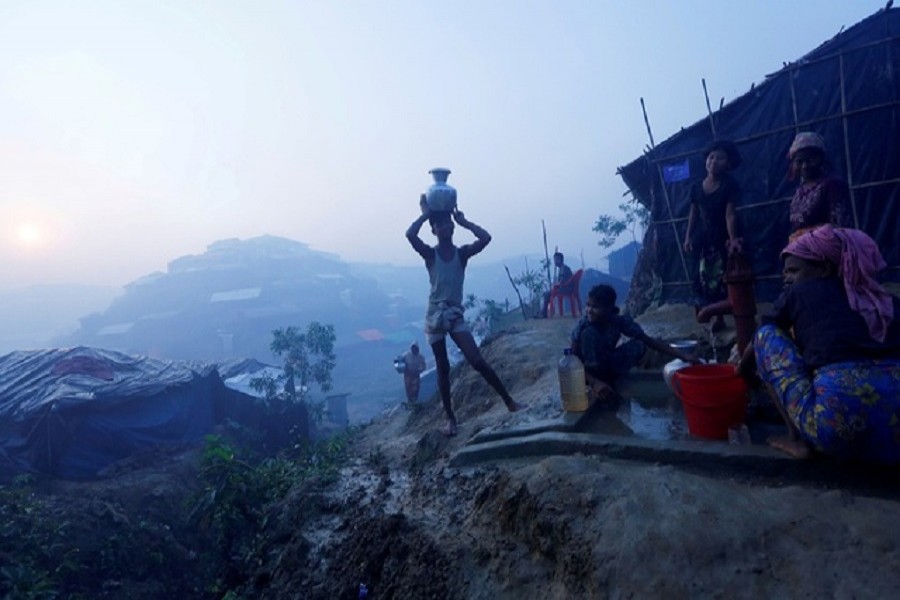Rohingyas brace for rains, landslides
'Race against the clock' to bolster Rohingya camps against rains, landslides
Rohingya refugees fill their containers with drinking water from a hand-pump at Balu Khali refugee camp near Cox's Bazar, Bangladesh Oct 26, 2017. Reuters/Files
Mohammad Rafiq was sitting in the shade of a tree, on a break from working to make his refugee camp in Bangladesh safer from the upcoming monsoon, when the hill above suddenly collapsed.
"I was buried up to my chest," he said from a bed in a tent hospital run by the Finnish Red Cross. "I felt like I was going to die."
His fellow labourers - Rohingya refugees from Myanmar, who were building up pathways with sandbags to raise them above floodwaters expected within weeks - strained Rafiq's arm pulling him from the dirt, and his hip was dislocated in the landslip.
The risks of landslides and other disasters in camps that shelter more than 865,000 refugees will soar with the monsoon, which runs from April to October, and the cyclone seasons in April to May and October to November, aid workers say.
The sand-and-clay hills have been stripped bare of trees, further increasing the threat.
Toilets could be washed into flooded areas crowded with families, spreading disease, while bamboo and tarpaulin huts stacked on slopes may come crashing down, relief agencies warn.
"We have a mass casualty plan," said Rea Noponen, team leader at the Red Cross hospital.
The hospital tents are built to withstand the monsoon, but would be blown away if a cyclone were to hit, she said.
Aid agencies are in a "race against the clock" to weather-proof the camps, said Suranga Mallawa of the European Union's humanitarian arm, ECHO, which is funding some of that effort.
Fatalities remain likely, she warned.
"There is a very high risk that we are going to lose lives in the coming months," she said.
Photo Reuters Photo Reuters The monsoon will put about 203,000 people in the Kutupalong "mega-camp" in danger, according to an assessment last month by the United Nations refugee agency (UNHCR) and the Asian Disaster Preparedness Center.
Many need to be moved from barren hillsides and flood-prone lowlands. The refugees arrived so quickly and in such great numbers, there was little time to prepare the camps and direct people to safe areas.
About 700,000 refugees have crossed into Bangladesh's Cox's Bazar District since Myanmar launched "clearing operations" after deadly attacks on its security forces by Rohingya militants in August.
Myanmar has rejected evidence its soldiers perpetrated widespread atrocities against Rohingya civilians.
Most of the fleeing Rohingyas crowded into the mega-camp, which grew to more than 580,000 people from about 100,000 in just four months, according to UNHCR figures.
“The scale and speed of this crisis has been unmatched in recent history,” Mallawa said.
Nature under pressure
Bangladesh prohibits refugees from earning a wage, but has allowed aid agencies to run "cash for work" projects that employ them to prepare the camps for the rainy season.
Dust rises as hundreds of workers use pickaxes to level more than a dozen hilltops, making way for heavy machinery to flatten 800 acres (324 hectares) the government has granted to expand the camp.
In the winding valleys below, refugees scour the land for firewood, between hills pockmarked with spots where they have resorted to digging up roots.
Agencies plan to move 24,000 of those most at risk to the new site as soon it is ready.
More will follow, but there is not enough space to relocate all 203,000 people now in areas prone to landslides and floods.
ECHO's Mallawa told the Thomson Reuters Foundation that an additional 1,500 acres of flat land is needed urgently.
Another concern is sanitation.
In Unchiprang camp, labourers wearing masks and blue overalls extract sludge from latrines, filling barrels they sling from bamboo poles and carry up a steep hillside to the treatment area.
About 20,000 latrines need to be "de-sludged", according to French charity Solidarités International.
If the work is not completed before the rains come - especially the most intense monsoon months from June to September - sewage could be washed into inhabited areas, causing outbreaks of diseases, including cholera.
Other workers reinforce slopes with bags of dirt, while the International Organization for Migration (IOM) runs workshops to provide refugees with techniques and kits to shore up shelters.
The IOM is also training some in first aid, and working with the World Food Programme to stock up on emergency supplies, including food and materials to repair shelters.
Light machinery is being stored at 10 "hubs" across the mega-camp for the purpose of repairing washed-out roads, which will cause "severe challenges" in delivering aid, said IOM emergency coordinator Manuel Pereira.
Although the first major influx of Rohingya refugees arrived in Bangladesh in the 1970s, this year the government has agreed to set up an emergency operations centre in Cox's Bazar, staffed with its own experts and international specialists.
Lack of funds
The future maintenance of the camp depends on money that has yet to materialise.
In March, the United Nations appealed for $951 million for the rest of the year. But less than a tenth of that is covered so far, said Mallawa.
ECHO has hiked its annual budget for disaster preparedness in Bangladesh to $7 million from $3 million last year.
That funding usually goes into projects across the country, but this year it will all be directed to the camps in Cox's Bazar, Mallawa said.
Mohammed Abul Kalam, Bangladesh's relief and refugee repatriation commissioner, called for international pressure on Myanmar to end the crisis by enabling the Rohingyas to return home and restoring their citizenship.
"It's not possible for us to host them for an indefinite period of time," he said in his office in Cox's Bazar, a beachside town that is the district capital.
"We are actually acting as the custodian of this population on behalf of the entire world."


